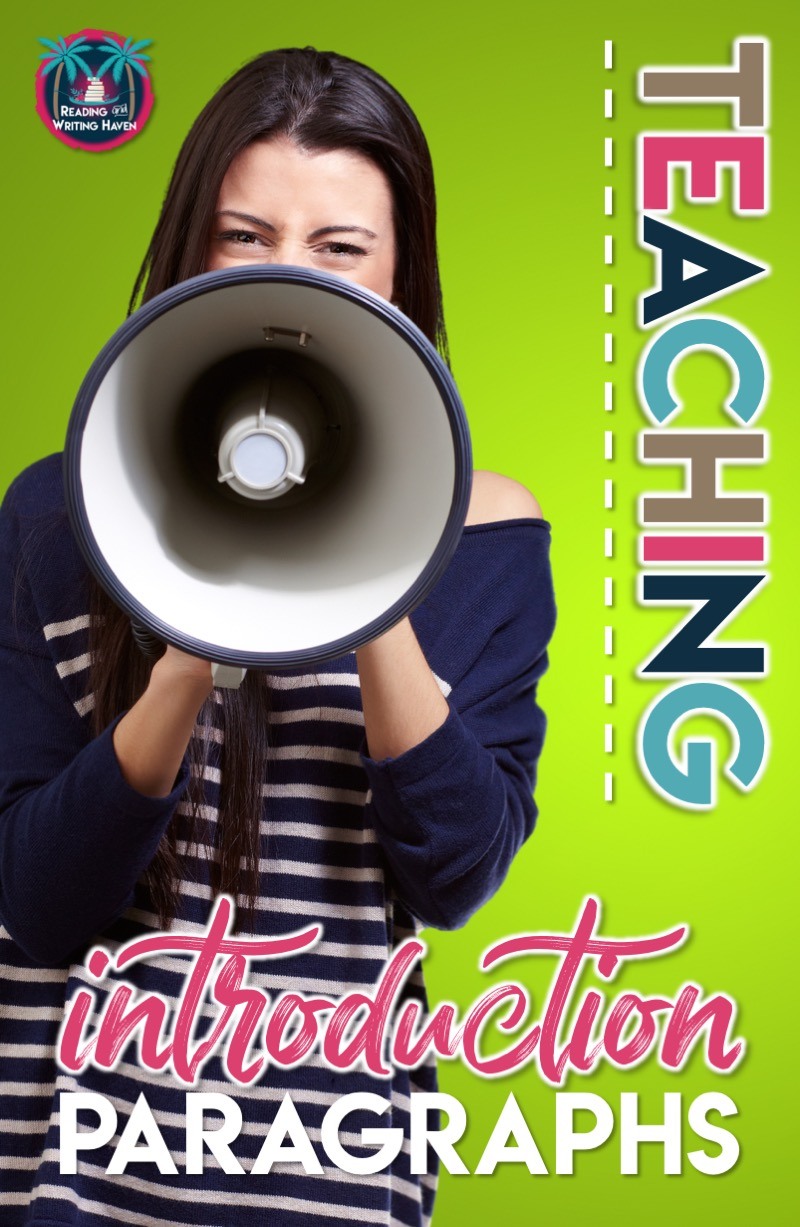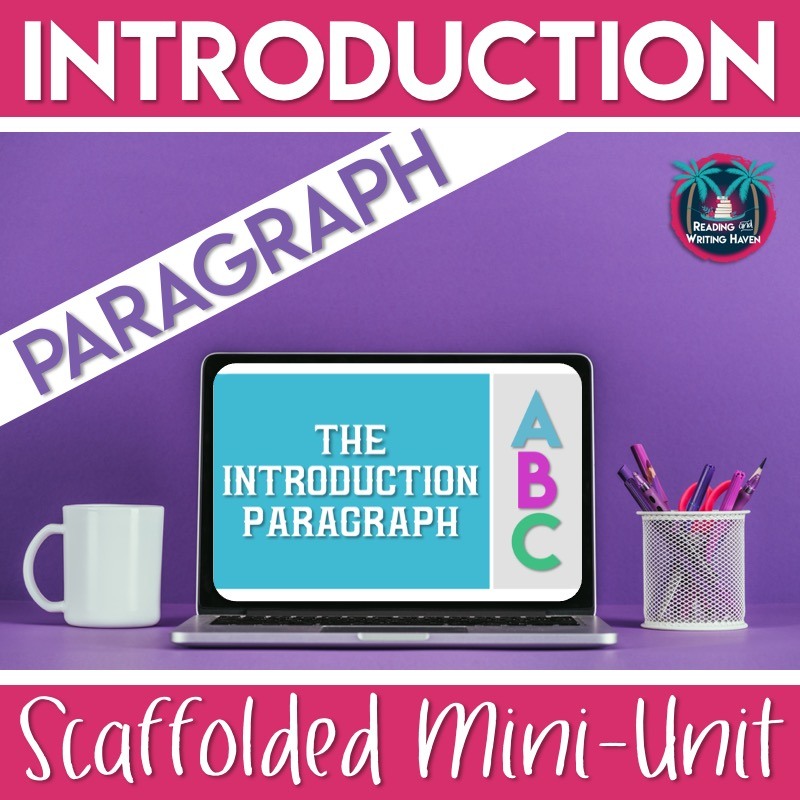Teaching Students How to Write an Introduction Paragraph
Perhaps you stumbled on this post after reading my prior post about choosing a research topic. Or, maybe you googled “how to write an introduction paragraph” because you are struggling to come up with a way to make introduction paragraphs less daunting for students.
Honestly, getting students started with their essay is the hardest part. Because I have a compulsion to reflect on and analyze my lessons and units, I am always trying to come up with no-fear, sensible ways to help students approach writing. In this post, I’m sharing the methods I use to make writing an introduction paragraph for an argumentative essay more transparent and concrete.
Begin with the thesis statement.
I always begin teaching students how to write an introduction paragraph by asking students to define their view. We begin by discussing how we would write thesis statements for debates that students would understand without much research. I explain to students that in an argumentative essay, the thesis statement is also called a claim because they are arguing a specific point. I want them to associate the term thesis statement with every essay we write, but it’s important that they know the word claim as well.
Identify the main points of argument.
Even though I don’t ask students to list their main points in the introduction paragraph, I consider it part of writing an intro. They need to understand whether or not their thesis statement can be developed with sound research. I give my students a graphic organizer that allows them to view the main points as pillars that support the thesis statement. If they can identify at least three solid pillars and provide evidence from research, they are approved to move on. (I do require students to begin collecting sources during the pre-writing stage, and I encourage them to tweak their original Works Cited page as they draft and revise.)
Explore attention getter options.
I like to give my students specific examples of strategies they can use as hooks. I also provide examples of each and then ask them to practice, which can look many different ways. Here are a few ideas:
- Display each hook strategy as a station around the room. Ask students to work in groups of 2 or 3 to write their own example for a topic they are assigned. They can then rotate around the room with the same topic, practicing different techniques, or they can present the strategy, example, and their own writing to the class.
- Ask students to experiment by choosing three different hooks. Have them write an attention getter for their essay for each type. Then, put students in groups and have them provide peer feedback on which approach is the strongest.
- Give students some task cards with attention getters already written. Ask them to identify the type of hook that is used on each task card. They can also evaluate that hook’s effectiveness.
Regardless of the type of hook students select, I always ask them to frame the essay in their conclusion. More on that in another post.
Teach specific ways to add background.
Even if students manage to come up with a hook they like and a sound thesis statement, they generally struggle with what to write in the middle. I explain that the middle of the introduction is a bridge in two different ways.
One, it bridges the hook to the thesis. Those two typically don’t flow naturally together. Two, it provides a bridge between the issue and the audience’s understanding of it. I allow my students to choose topics they are passionate about, but I explain that other people who will read their essay might not know anything about the topic. I ask them, “What information does your audience need to know in order to fully understand this debate?”
Does the topic have an important history? Are there relevant court cases? How long has this issue existed? Is it currently in the news? Does it impact people locally, nationally, or globally? Can it be related to or a cause of any other issues in our world? Are there any terms the audience might need defined? Who disagrees about this topic, and why? These are some of the probing questions I ask students to ponder.
Use acronyms.
I’m a writer who appreciates structure. Not all students need it, but giving them an acronym to help them remember the basics of a paragraph can’t hurt. I developed the ABC acronym for writing argumentative introductions because it’s so easy to remember.
A: ATTENTION GETTER / HOOK
B: BRIDGE / BACKGROUND
C: CLAIM / THESIS
Even students who don’t need much scaffolding must understand that those elements are necessary in order to grab the audience’s attention, fill in gaps of knowledge, and establish a sound position.
Make feedback social.
I find it important to give students feedback on their introduction paragraphs before moving on to the body of the essay. Feedback is an opportunity to boost students’ confidence. They will enter the next stage of their paper knowing their foundation is solid. But, feedback doesn’t have to always come from the teacher.
My favorite activity I’ve ever done to make feedback social is this. Ask students to bring in three versions of their introduction paragraphs. Have them use a different hook in each but keep the rest the same. Make sure they are paper clipped or stapled together.
Then, sit in a circle. Ask students to pass the essays either to the right or the left one person. For five or ten minutes, just sit and allow students to respond to the introduction paragraphs. Students can write praises and suggestions either on the actual paper copies or on post-its. Give them some prompts to consider to guide their feedback.
After time has lapsed, have students pass again in the same direction. Do this as many times as you can before they lose focus or before the period is over. This activity can also be conducted digitally. I just prefer the paper version because it feels more authentic and is easier to manage.
And that’s what I do to teach students how to write an introduction paragraph. I know some people encourage students to begin with the body paragraphs, and that’s fine. We all have to find what works for our teaching style and for our students. Even if students begin in the middle, they’ll have to come back to the beginning at some point.
Interested in reading more? You might enjoy one of these related articles…
- How to use examples to support students’ writing process for body paragraphs
- How to teach students to write a strong conclusion (with scaffolding!)
RELATED RESOURCE:
This is the mini unit I use to teach how to write an introduction paragraph. It contains the ABC acronym, the pillars and introduction paragraph graphic organizer, examples of hooks, ideas for what to include in the bridge, and an example introduction paragraph. Click on the image to take a closer look at the details.


